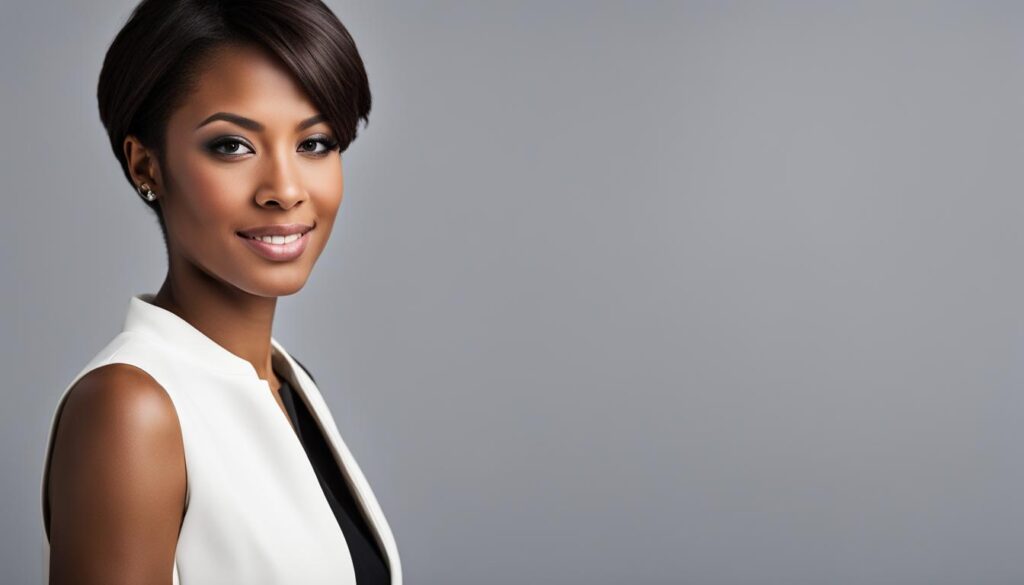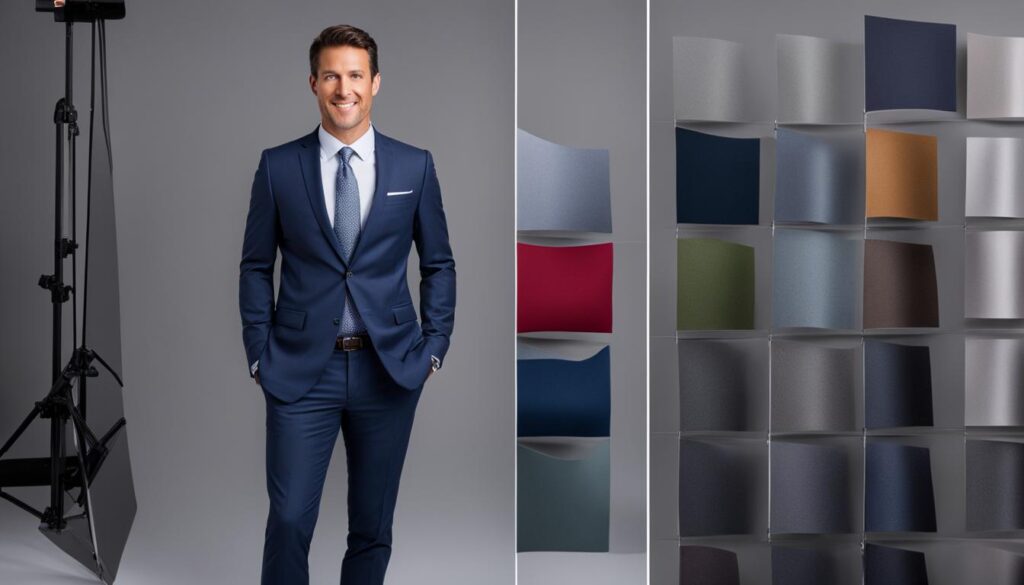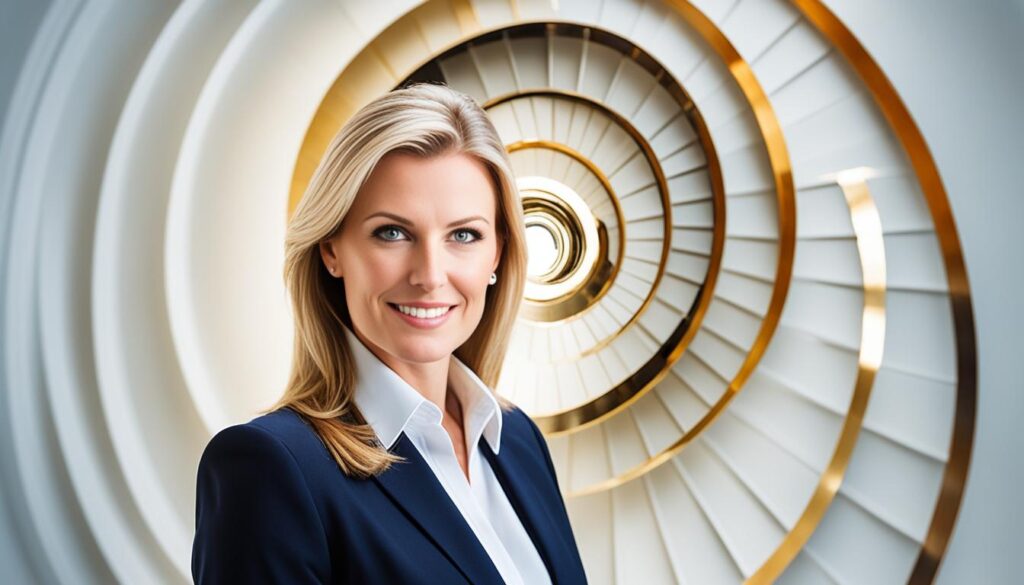Understanding Composition – Framing Your Corporate Headshots
Have you ever looked at a photograph and instantly felt drawn to it, captivated by its beauty and visual impact? I have. It was a corporate headshot of a friend of mine, and the composition was breathtaking.
The photographer had expertly applied the rule of thirds, creating a perfect balance between the subject and the negative space around them. The depth of field and leading lines led my eye straight to the focal point, while the golden ratio subtly enhanced the overall composition. It was a work of art.
That moment made me realize the incredible power of composition in photography, especially regarding corporate headshots. How an image is framed can completely transform its impact and convey the essence of a professional persona.
In this article, we will explore the importance of composition in professional imagery, diving into techniques such as the rule of thirds, negative space, depth of field, leading lines, and the golden ratio. By understanding and applying these composition techniques, you can frame your corporate headshots effectively and create visually pleasing compositions that leave a lasting impression.
So, let’s embark on this composition journey and discover how it can elevate your corporate headshots to a whole new level.
Key Takeaways:
- Composition is a powerful tool that can transform the impact of your corporate headshots.
- Techniques like the rule of thirds, negative space, depth of field, leading lines, and the golden ratio can enhance your composition.
- Understanding and applying these composition techniques can help you create visually pleasing and impactful corporate headshots.
- Experiment, practice, and develop your unique style within the realm of composition to create captivating corporate headshots.
The Significance of Composition in Professional Imagery
Composition plays a crucial role in professional imagery, as it can enhance the visual impact of photographs. It helps to guide the viewer’s eye, create balance and harmony, and tell a story through visual elements. In the context of corporate headshots, a well-composed photograph can convey professionalism, confidence, and trustworthiness, which are essential qualities for individuals representing a corporate brand.

When capturing compelling photographs, it’s not just about clicking the shutter button. Attention to composition is key to creating visually appealing images that leave a lasting impression. How elements are arranged within the frame can significantly affect the overall impact and effectiveness of the photograph.
Professional imagery is not just about capturing a subject; it also involves crafting a visually engaging and aesthetically pleasing composition. A well-composed photograph grabs attention, captivates the viewer, and tells a story. It helps to establish a connection between the subject and the viewer, conveying emotion, purpose, and intention.
Understanding the importance of composition allows photographers to make deliberate choices in framing their shots. By considering factors such as the placement of subjects, lines, patterns, shapes, and negative space, photographers can create visually pleasing compositions that draw the viewer’s attention and provoke a desired emotional response.
Composition in professional imagery can enhance the visual impact by:
- Creating balance and harmony in the frame
- Guiding the viewer’s eye towards the main subject
- Eliciting specific emotions and responses
- Conveying professionalism and trustworthiness
- Telling a story or conveying a narrative
A well-composed professional photograph captures the subject, communicates a message, and leaves a lasting impression. It can elevate the overall quality of the image and make it more compelling and memorable.
Next, we will delve deeper into specific composition techniques and how they can be applied to corporate headshots to create impactful and visually appealing images. Understanding and mastering these composition techniques will empower you to take your professional imagery to the next level and create photographs that captivate and resonate with viewers.
Embracing the Rule of Thirds for Balanced Corporate Portraits
The rule of thirds is a fundamental composition technique in photography, and it can be particularly effective when capturing corporate portraits. Photographers can create visually balanced and engaging compositions by dividing the frame into thirds vertically and horizontally. This technique involves aligning key elements with the intersection points of the rule of thirds grid, guiding the viewer’s eye to the main subject and creating a sense of harmony.
Defining the Rule of Thirds
The rule of thirds divides the frame into nine equal parts using two horizontal and two vertical lines. The resulting grid consists of four intersection points where the lines meet, which serve as natural focal points within the composition. By positioning essential elements, such as the subject’s eyes or other key features, along these intersections, photographers can create visually appealing and well-balanced portraits.
The Rule of Thirds in Corporate Headshots
When applying the rule of thirds to corporate headshots, photographers can achieve a more dynamic and visually pleasing composition. By positioning the subject’s face along one of the vertical lines and aligning their eyes or other prominent features with the intersection points, photographers can create a sense of balance and visual flow. This technique adds interest to the composition and draws the viewer’s attention to the subject, making the portrait more compelling and impactful.
Aligning Features with the Intersection Points
When composing corporate headshots, it is important to consider the positioning of critical elements within the frame. Photographers can enhance the overall composition by aligning facial features, such as the eyes, mouth, or other distinctive characteristics, with the intersection points of the rule of thirds grid. This technique helps to create a visually balanced and engaging portrait by guiding the viewer’s eye to these important details.

Embracing the rule of thirds is a valuable composition technique for creating balanced and visually appealing corporate portraits. By dividing the frame into thirds and positioning critical elements along the intersection points, photographers can guide the viewer’s eye and create a sense of harmony in their compositions. In the context of corporate headshots, applying the rule of thirds can result in more engaging and impactful portraits that communicate professionalism and capture the viewer’s attention.
Employing Natural Frames to Enhance Subject Focus
One powerful composition technique that can significantly enhance the subject focus in corporate headshots is employing natural frames. By framing the subject with natural elements such as trees, branches, arches, or windows, you can draw attention to the main topic and add depth and visual interest to the composition. This technique allows you to create a sense of context and tell a story within the frame.
When utilizing natural frames, it’s essential to consider the foreground elements that will frame your subject. Choose components that complement and enhance the overall composition, creating a visually appealing frame. Experiment with different angles and perspectives to find the most effective framing for your subject.
By incorporating natural frames in your corporate headshots, you can create a captivating composition that highlights the subject and adds a unique touch to the overall image. It’s essential to carefully select and position the natural elements to ensure they enhance the subject’s focus and contribute to the story you want to convey.

The image above demonstrates the use of natural frames in a corporate headshot. The subject is beautifully framed by the tree branches, drawing attention to the person’s face and creating a sense of connection with the natural surroundings. The natural frames add visual interest and depth to the composition, enhancing the subject’s focus.
Leveraging Negative Space for Stronger Compositions
What is Negative Space?
Negative space refers to the empty or blank areas in a photograph that surround the main subject. It is a powerful composition technique that can direct attention to the subject, create a sense of simplicity and minimalism, and evoke certain emotions in the viewer. By strategically incorporating negative space in your corporate headshots, you can enhance the overall composition and make the main subject stand out.
Using Negative Space to Direct Attention
With ample negative space around your subject, you can create visual breathing room, allowing the viewer’s eye to focus directly on the main subject. This can be particularly effective in corporate headshots, as it directs the viewer’s attention to the individual, their facial expressions, and their professionalism. Negative space can also help eliminate distractions and clutter, creating a visually clean and uncluttered composition.
The Impact of Negative Space on Corporate Headshots
Leveraging negative space in corporate headshots can significantly impact the composition and storytelling. Incorporating negative space creates a sense of balance, harmony, and visual contrast. It can evoke a feeling of calmness, professionalism, and authority, making the subject appear confident and trustworthy. The minimalist approach in using negative space allows the main subject to take centre stage, creating a powerful and visually striking composition.

| Negative Space | Impact |
|---|---|
| Creates visual breathing room | Directs attention to the main subject |
| Eliminates distractions | Creates a clean and uncluttered composition |
| Evokes calmness and professionalism | Portrays confidence and trustworthiness |
| It brings balance and harmony | Enhances the overall composition |
Choosing the Right Backdrop and Props
Selecting the right backdrop and props is crucial when composing an impactful corporate headshot. The backdrop is the composition’s foundation, setting the image’s tone and atmosphere. Consider the style and branding of the company or individual you photograph, and choose a backdrop that complements their aesthetic. A clean and simple backdrop, such as a solid colour or a textured wall, can create a professional and timeless look. On the other hand, a more elaborate backdrop, such as a cityscape or an office environment, can add context and personality to the headshot.
Props can also be used strategically to enhance the composition and tell a story. For example, a professional holding a tablet can convey their expertise in the digital realm. At the same time, a person wearing a lab coat and holding a clipboard can suggest their role in the scientific or medical field. Props should be relevant to the individual’s profession or the company’s industry and should not distract from the main subject of the headshot.

Evaluating Angles and Perspectives
Angles and perspectives play a vital role in the composition of corporate headshots. Different angles can create various visual effects and evoke specific emotions. Before taking the shot, consider the message you want to convey and the impression you want to leave. Experiment with high angles, low angles, and eye-level perspectives to find the most flattering and engaging angle for the subject.
The angle of the shot can also affect how the subject’s features are framed within the composition. By tilting the camera slightly up or down, you can emphasize certain facial features or create a sense of depth. Be mindful of the subject’s posture, facial expressions, and body language, as they can contribute to the overall composition and convey the desired message.
Cropping Techniques to Highlight the Main Subject
Cropping is a powerful technique for highlighting the main subject and creating a well-composed image. By adjusting the framing and eliminating unnecessary elements, you can draw the viewer’s attention to the most critical aspect of the headshot. Cropping can also help achieve the desired visual balance and remove distracting elements from the composition.
When cropping a corporate headshot, consider the rule of thirds as a guideline. Position the main subject along the intersecting lines or at the intersection points to create a visually pleasing composition. Additionally, please pay attention to the negative space around the subject and use it to enhance the overall composition.
By carefully choosing backdrops and props, evaluating angles and perspectives, and utilizing cropping techniques, you can enhance the composition of your corporate headshots and create visually compelling images that effectively represent the individual or company they portray.
Depth of Field: Blurring the Line between Subject and Background
Depth of field is a composition technique that can create a visual separation between the subject and the background in corporate headshots. By controlling the depth of field through aperture settings, you can blur the background and draw attention to the main subject. This adds a three-dimensional quality to the composition and helps to create a focal point within the frame.
When using depth of field, the subject-background separation becomes more pronounced, allowing the subject to stand out prominently. By deliberately blurring the background, you can eliminate distractions and direct the viewer’s focus to the main subject, an individual or a group of people. This technique adds depth and dimension to the image, enhancing its overall visual impact.
To achieve the desired depth of field in your corporate headshots, you need to adjust the aperture settings on your camera. A wider aperture (smaller f-number), such as f/2.8 or f/4, will create a shallow depth of field, resulting in a more pronounced subject-background separation and a blurred background. On the other hand, a narrower aperture (larger f-number), such as f/11 or f/16, will increase the depth of field, keeping more of the scene in focus.
When using depth of field as a composition technique, it’s essential to consider the placement of the focal point within the frame. The focal point is the area of the image that is in sharp focus and draws the viewer’s attention. By placing the main subject at or near the focal point, you can create a visually compelling composition that effectively communicates your desired message.
In summary, depth of field is a powerful tool for visually engaging corporate headshots. By blurring the background and drawing attention to the main subject, you can achieve a solid subject-background separation and create a clear focal point. Experiment with different aperture settings to control the depth of field and enhance the overall composition of your corporate headshots.
Incorporating Leading Lines for a Dynamic Visual Flow
Regarding composition in corporate headshots, leading lines are a powerful tool for creating a dynamic visual flow that guides the viewer’s eye through the photograph. Leading lines within the frame naturally draw attention and develop a sense of movement and depth. Strategically incorporating leading lines, such as roads, paths, or architectural lines, can add visual interest and create a captivating composition.
Using leading lines helps create a visual journey for the viewer, leading their eye towards the photograph’s main subject. The lines act as a visual pathway, guiding the viewer’s gaze and creating a sense of connection between elements within the frame. This technique not only adds a dynamic element to the composition but also ensures that the viewer’s attention is directed towards the intended focal point of the headshot.

Exploring the Golden Ratio in Headshot Composition
The golden ratio is a mathematical concept used for centuries in art and design to create aesthetically pleasing compositions. When applied to headshot photography, understanding and utilizing the golden ratio can significantly enhance the visual impact of your compositions. One way to represent the golden ratio is through the Fibonacci spiral, which starts from the centre and expands outward, following the golden ratio proportions.
Understanding the Golden Ratio
The golden ratio, often denoted by the Greek letter phi (φ), is a proportion of approximately 1.618. This ratio is believed to be visually pleasing and harmonious to the human eye. It can be found in various natural and man-made structures, such as the Parthenon in Athens and the paintings of Leonardo da Vinci. Applying the golden ratio in headshot composition helps create a sense of balance, symmetry, and overall aesthetic appeal.
Applying the Golden Ratio to Headshot Photography
In headshot photography, you can apply the golden ratio by positioning key elements or the main subject along the Fibonacci spiral. By aligning the facial features or other significant aspects with the spiral, you can achieve a visually pleasing composition that draws the viewer’s attention to the focal point. This technique adds a sense of visual flow and harmony to your headshots, making them more compelling and engaging.
Fibonacci Spiral in Composition
The Fibonacci spiral is derived from the Fibonacci sequence, a series of numbers in which each is the sum of the two preceding numbers (e.g., 0, 1, 1, 2, 3, 5, 8, 13, 21…). When this sequence is visually represented, it forms a logarithmic spiral known as the Fibonacci spiral. In headshot composition, the Fibonacci spiral can guide the placement of key elements, creating a visually dynamic and aesthetically pleasing composition.

Conclusion
A strong understanding of composition and framing techniques is crucial for creating impactful and visually appealing corporate headshots. You can elevate your headshots‘ quality and visual impact by incorporating key composition principles into your photography, such as the rule of thirds, natural frames, negative space, depth of field, leading lines, and the golden ratio.
Composition in photography is arranging the elements within your frame to create a balanced and engaging composition. In the context of corporate headshots, this means considering the placement and positioning of the subject, background, and other visual elements to convey professionalism and make a strong visual statement.
Employing techniques such as the rule of thirds, which divides your frame into nine equal parts, and using natural frames like trees or arches to enhance subject focus can create visually pleasing and well-composed headshots. Additionally, utilizing negative space to direct attention, incorporating leading lines to create a dynamic flow, and understanding the golden ratio for aesthetically pleasing compositions can further enhance the impact of your corporate headshots.
Remember, honing your composition skills requires practice and experimentation. Not every rule or technique will work in every situation, so developing your unique style within composition is essential. You can create captivating corporate headshots that convey professionalism, tell a story, and leave a lasting visual impact.
FAQ’s
Q: What is composition in photography?
A: Composition in photography refers to how elements are arranged within an image to create a visually appealing and meaningful picture.
Q: Why is composition essential in photography?
A: Composition is essential in photography because it can make or break a photo. A well-composed image can effectively convey a message, while a poorly composed one can be confusing or uninteresting.
Q: What are some standard composition techniques in photography?
A: Some standard composition techniques in photography include the rule of thirds, leading lines, framing, symmetry, and patterns.
Q: How can I improve my photography composition?
A: You can improve your photography composition by practising regularly, studying the work of other photographers, experimenting with different techniques, and seeking feedback from others.
Q: Should I always follow the composition rules?
A: While it’s important to understand composition rules, don’t be afraid to break them if it helps you achieve your creative vision or create a more exciting photograph.
Q: What are some essential camera settings to consider for composition?
A: Some vital camera settings to consider for composition include aperture, shutter speed, and focal length, which affect how your composition looks.
Q: How does street photography relate to composition?
A: Street photography often relies heavily on composition to capture the essence of a scene or convey a story without staging. Paying attention to composition can help street photographers create visually compelling images.








